How to pack for a climbing trip?
How to pack for the trip? What gear to bring? What clothes? Anything else that is important?
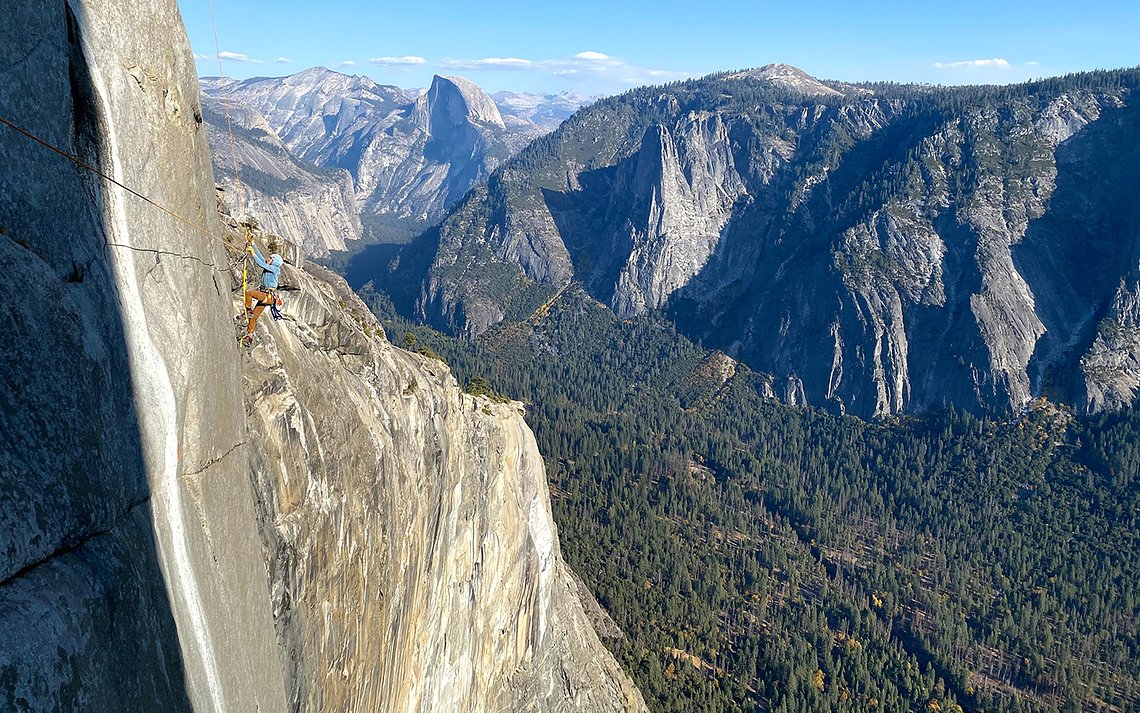
Tue 22 Mar 2022
We have been getting questions from a lot of you about what are you expected to bring to a trip, and how to pack for a climbing holiday. So let us look at how to pack for an adventure holiday, and what kind of gear do you need for each trip. If you are only interested in what kind of clothes to bring, jump to the end of this post. And please, when it comes to specific gear, take this as a general advice only. If you have any questions, get in touch!
Gear
Sport Climbing
Sport climbing is generally on bolted routes. You climb up and use metal bolts in the rock (kindly provided by a saint stranger) to put quickdraws in which you hoop the rope. On top, there is usually a chain with a carabiner or a ring through which you can put the rope. Our sport climbing trips are for everyone, but we do expect you to be a climber. That means that you may have climbed indoors and that you know how to belay safely. When you are coming to a sport climbing holiday, we think that you already have your own shoes (broken in and comfy), your harness, a belay device you are comfortable using, a rope and a set of quickdraws. Let us sum it up:
- Shoes
- Harness
- Belay Device
- Chalk bag
- Rope
- Quickdraws
- Sling and locking carabiner ... and you pack all of that into a nice sized
- backpack
And that should do you for a wonderful week of adventures! You will love the sport-climbing trips, as our destinations are just incredible, while the quality of rock and routes are some of the best in the World. In some places we will provide guide books with topos, or you can pick our guide's brains for the best routes in the area. If you would like more information, keep on reading:
Shoes
Reading about buying new climbing shoes can be so exhausting, so let me give you some general pointers. Sizes are just numbers on boxes. When it comes to buying climbing shoes from a brand you haven't bought before (or even a different type from the same brand), nothing beats trying them on first. Secondly, there was a long tradition of painful climbing shoes. Why is that? Small shoes put extra pressure on toes. While that may give you the upper hand when you are smashing your project (a really hard route you are working on), let me tell you that in the long run, it is better to be comfortable. You will spend many hours climbing for many consecutive days. This gets old quickly if your feet are in constant pain. The same goes for how technical the shoes are (how curved is the sole). They range from flat (comfy) to very aggressive (sole at a curved angle). I personally prefer semi-aggressive shoes just my size, where I get the feeling of support on small holds, but the shoes do not cause me a great deal of pain.
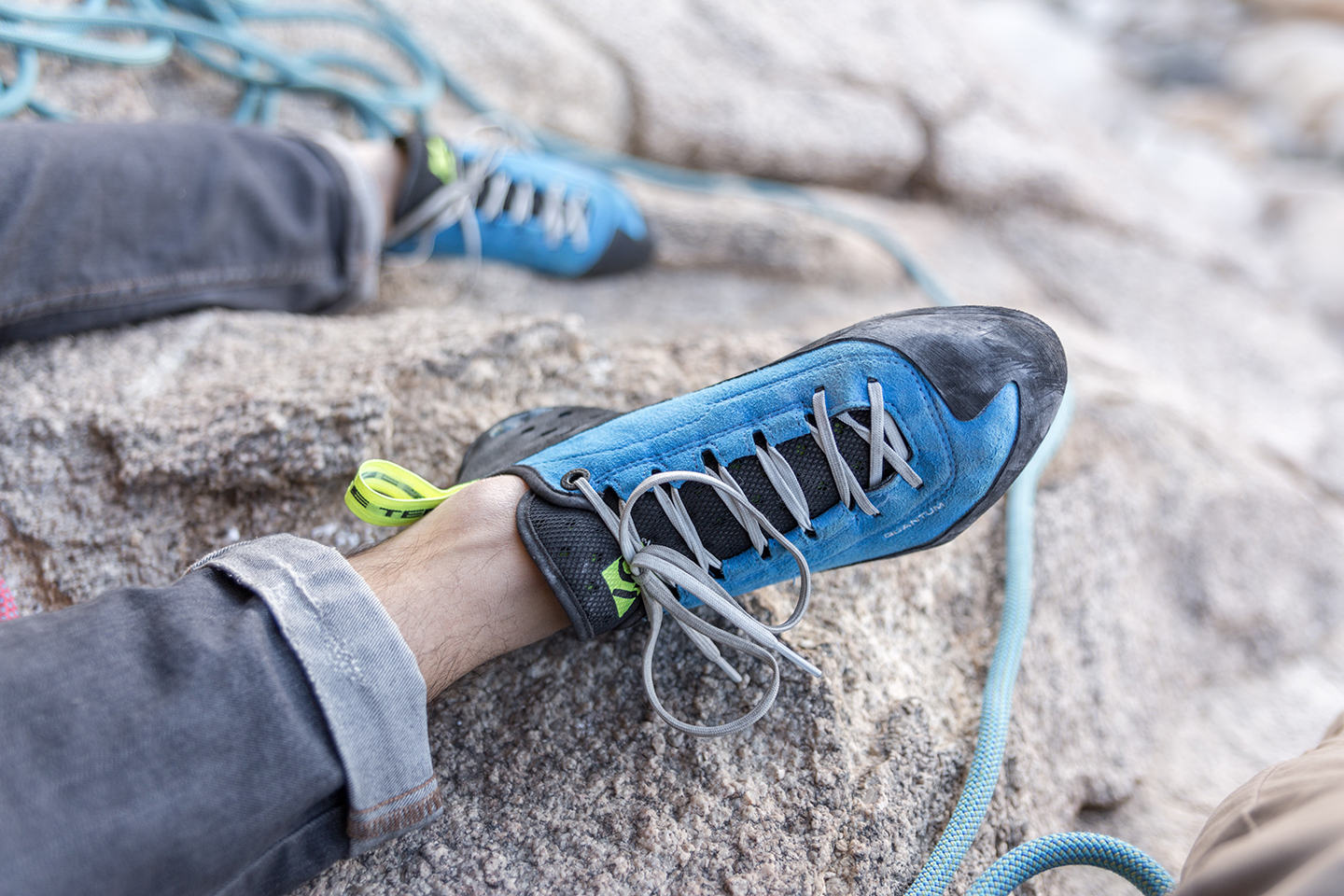
Shoe laces or lycra straps? Shoe laces mould the shoe better to the shape of the foot, achieving higher comfort for long periods of time (multi-pitch), whereas lycra put pressure on the right places quickly (ideal for sport crags)
Rope
There are different types of ropes. The first divide is Static and Dynamic. You want a dynamic rope. That means that, when taking a fall, the rope elongates dynamically, spreading the force of the impact. Dynamic ropes are further divided into single, double, and twin ropes. This refers to how you use them. The single rope you use on its own. Double ropes are two ropes used together usually on trad or multipitch routes, and each of them can hold two seconds, and twin ropes need to be always used together.
Why all this? It does not matter now. You want a single rope. Nice, single, thick rope that will safely catch your falls. Single ropes then go by thickness. Generally, the thicker, the more durable, the heavier to carry around. If you are looking to buy a new rope, a single rope somewhere between 9 and 10mm is what you could go for. Finally, the length of the rope. The longer the rope, the further you can climb - and get back down. Most people used to buy 60 meters rope, as that allowed you to do any length up to 30 meters routes. However, nowadays we recommend you to get an 80 meters one, since many of the new routes are 35 - 40 meters long. Places like Chulilla, El Chorro, Siurana, Oliana, Céüse and so on have routes that are up to 50 meters. Bearing this in mind, when you're climbing a long single pitch route, always tie a know at the end of the rope to avoid it sliding through your gri-gri or ATC when putting down your partner.
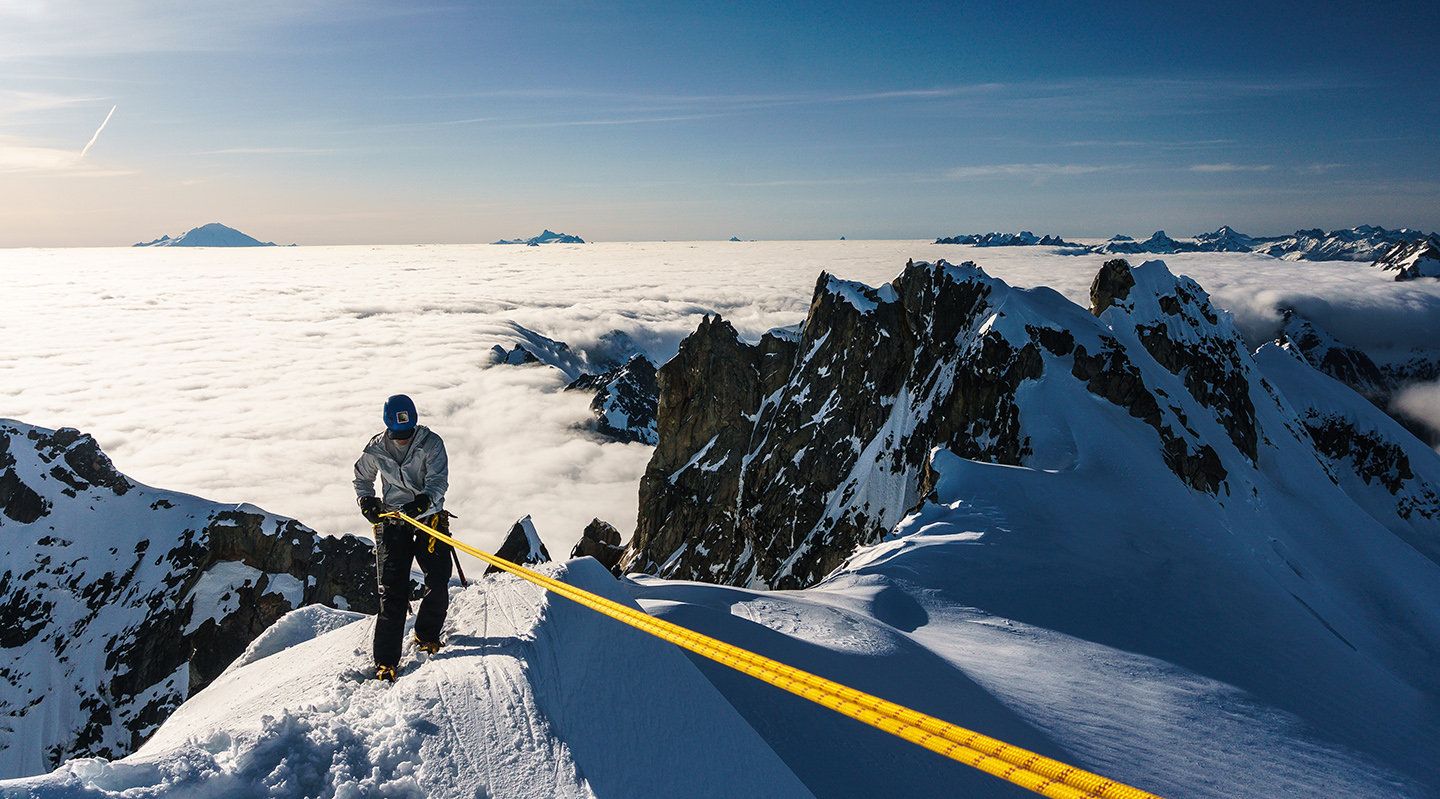
Using double ropes in the North Cascades National Park, Washington US
Quickdraws
A set of 10-15 is customary, and you might want to vary their length (12-20cm).
Belay device
Take the one you are already comfortable using. The standard ones such as Petzl Reverso are unbeatable multipurpose classics, whereas self-locking devices such as Gri-Gri or the BD dinosaur might be preferable when you belay all day at a sports crag.
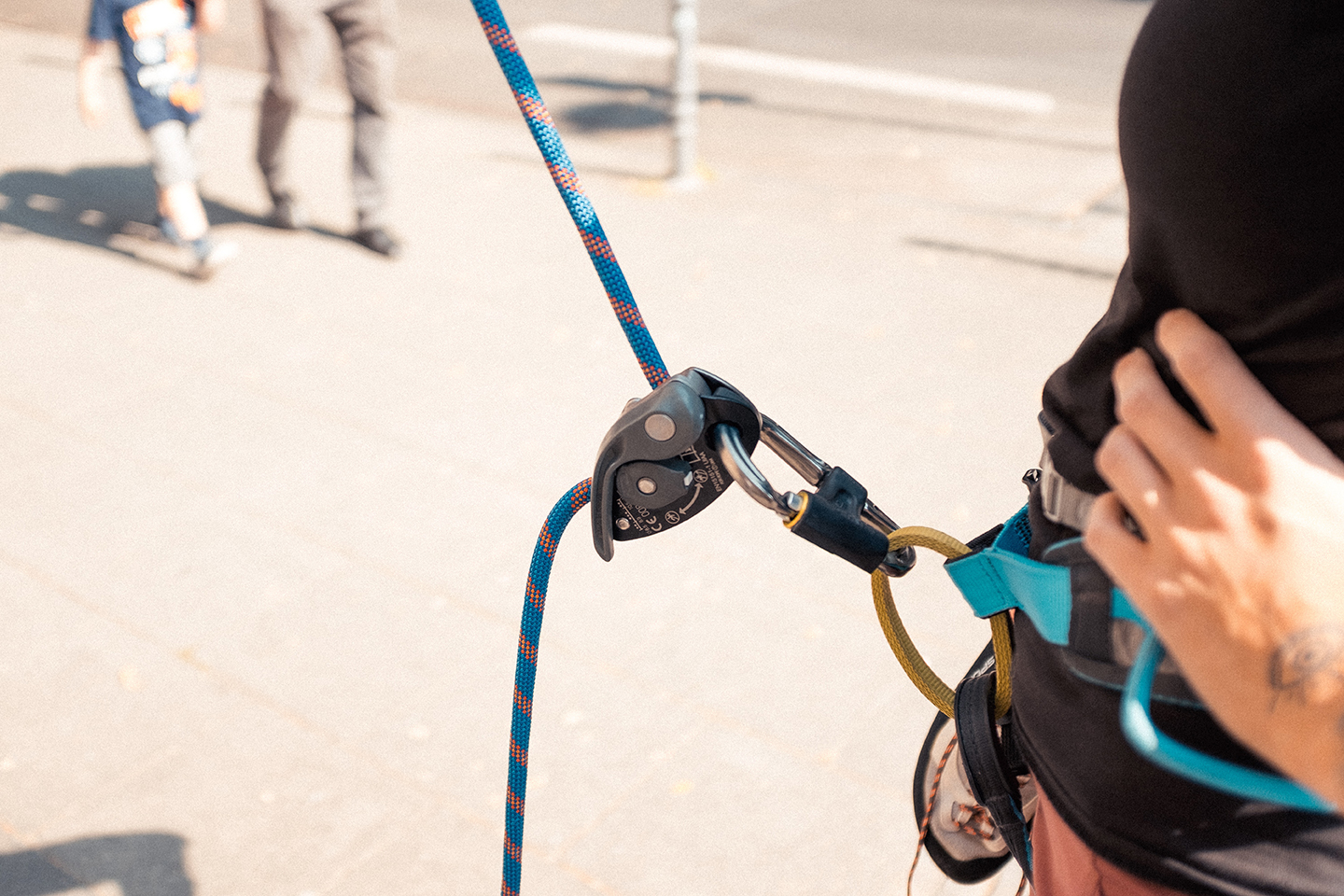
Petzl Gri-Gri, probably the most popular belaying device for sport climbing
A sling and a locking carabiner
It is a good habit to have one or two of those spare with you. A 60cm sling and a couple of lock carabiners. Sometimes you need to use them when you climb up a sport route - on the top, to put a rope through a maillon. If you do not know how to do that, ask your climbing guide! They will be more than happy to assist.
Backpack
Nanananananana.... BACKPAAAACKS! There are so many, and they are so wonderful. But which ones to bring to a climbing holiday? As you will be expected to be mobile, independent, and to fit to a van or a car with other climbers, my go-to is a large 60-80litre backapck and a day 20-35litre bag (which, packed nicely, works on a plane as one hold-in and one small lugagge). If you already have a backpack, then do not worry about the next bit; any kind of backpack can serve you well. If you are looking for a backpack to buy, here is what works for me. My personal preference are climbing technical backapacks. The are made from light, durable materials, and have a lot of handy technical features, such as gear loops, straps to attach gear, handy pockets and helmet holders. And they do not have to cost an arm and a leg: you can keep an eye out on sales in outlets or check the Decathlon's superb brand Simond.
On final note, unless it is an absolute necessity, please do not turn up with a couple of large suitcases.
Canyoning
Our canyoning trip is just wonderful - for all levels - and all you need to bring is your swimsuits and trainers you don't mind using in the water! You will be fully equipped with equipment on the spot. If you really want to bring your own, then a wetsuit and helmet are the essentials. You will be taught how to use rope and other canyoning equipment, but these will be supplied by our guides.
Bouldering
When going bouldering, all you need are climbing shoes, chalk bag..... and crash pads.
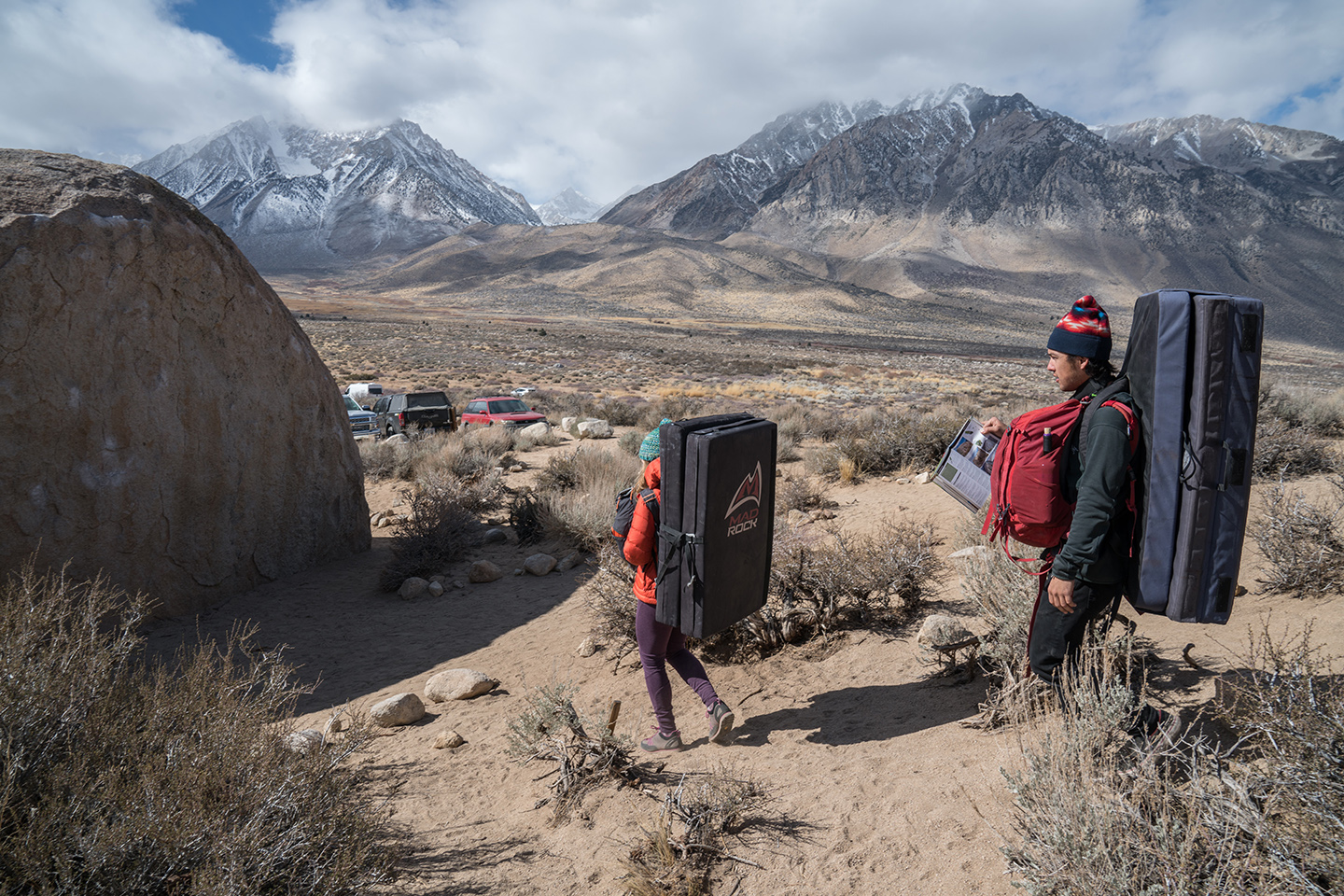
Bouldering in Buttermilk Boulders, Bishop, United States
Multi-pitch and Trad Climbing
Multi-pitch and trad-climbing trips are for the more experienced. You are expected to be an autonomous climber, knowing the ins and outs; including owning the gear that comes with it. On the multi-pitch route, you might wish to bring double ropes to reduce drag and slings and carabiners to set up belay stations. On trad, you have to make sure to get gear to place protection. You also want to read about the rock where are you going to climb. In some places, it is frowned upon to use metal protection, and you will be climbing with cordelettes with knots on them (keep that sweet sweet rock free of chalk, too!), but in most instances, you will be fine with a set of nuts and cams. As for the topos, there will be guide books at the destination, or you can get them through our website, but in all cases you can ask our guides and they will help you to navigate, and decide on the best area to explore depending on the weather and time of the year.
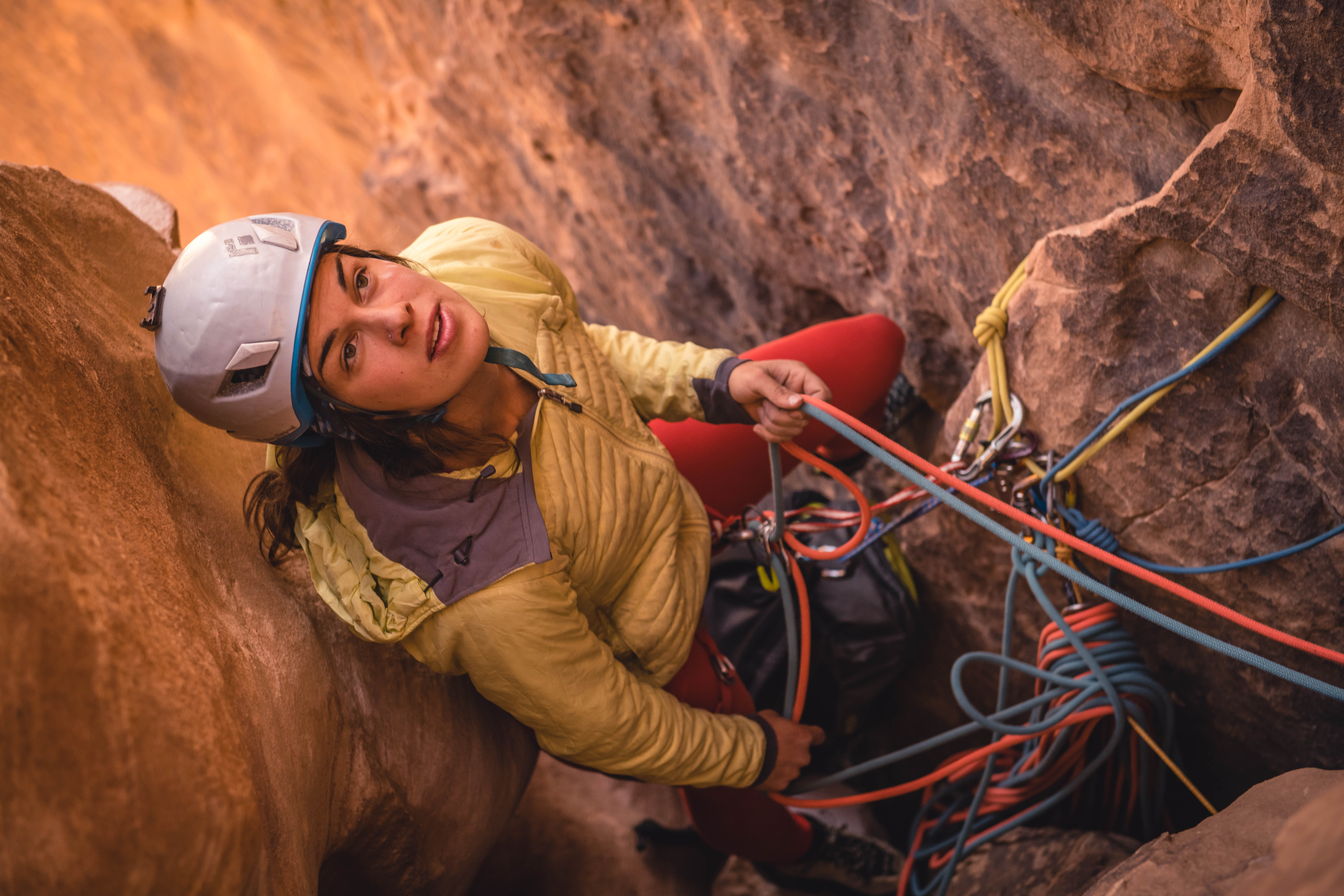
Kaleigh Carlson in Wadi Rum, see the rustic anchor
Clothes
What clothes do you bring with you? This obviously depends largely on the destination and season, however, there are a few items that I find always in my backpack. Let me share these secrets to comfortable trips with you.
Trainers
Climbing inevitably includes some amount of walking. From the carpark to a crag, from car to a mountain, coming back from a multi-pitch. While climbing, you are standing around belaying your friends. And romantic walks on the beach during sunset. That is not part of climbing, but I like to do it on holidays. So anyway, this is a sports activity in nature, but, in my eyes, not natury enough to require big boots. I like to use grippy trainers such as La Sportiva Approach line or Adidas Terrex trail running shoes. If you want to be real fancy around crags, bring a pair of flip-flops to change into when not climbing.
Jacket
The secret to happiness is Layers, Layers, Layers... Bring layers. Tank top, T-shirt, Long-Sleeve, Sweat-shirt, and a jacket. That will do you for any type of weather. What Jacket? Why, I am glad you asked. Fluffy down jackets are climbers' go-to. They are supreme in weight and come with a little baggie you can stuff them into (and clip onto your harness). They have excellent wind-breaking and warm-keeping properties - an important feature around windy crags. Oftentimes, it happens that I am sweating in the sun, climbing past sunset, the wind picks up and the temperature drops rapidly, especially in the mountains. These bad boys keep me safe. And for when the weather really takes a bad turn, the combo: a down jacket, and a Gore-Tex jacket - is an unbeatable classic, keeping all the wind and rain on the outside, and all the warmth on the inside.
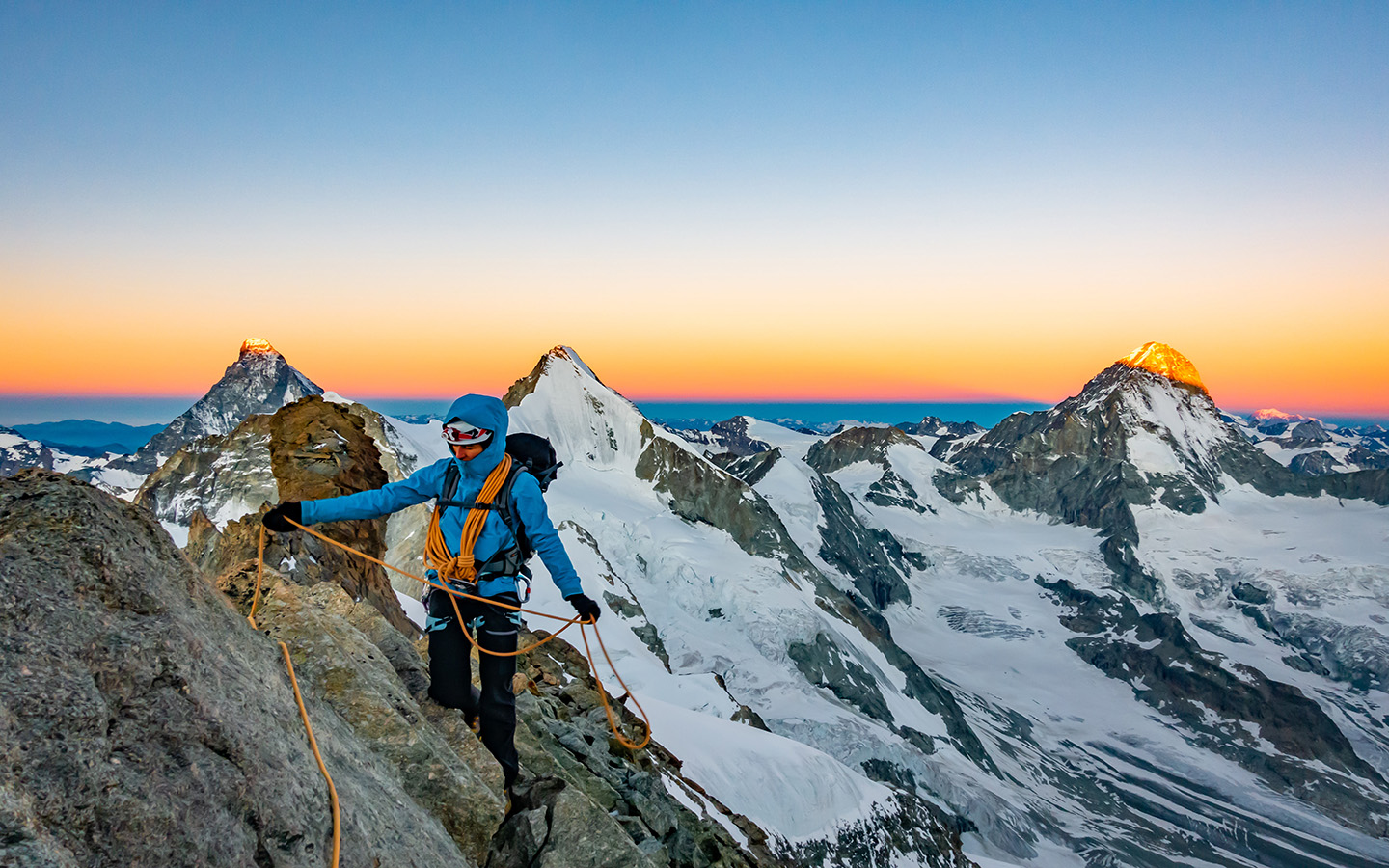
Using 3rd layer Gore-Tex jacket in the Alps
Trousers
I am no fan of trousers. If you are like me, climbing in jeans is a heresy! I like to feel free. My trick is shorts, and when it is a bit colder, the magic Leggins and Shorts combo. However, I feel like I have reached adulthood - and purchased some Patagonia climbing trousers. They are ace! Ah the stretch, the freedom of movement, unknown to me before! I bow to thee...
That is about it. On most trips, make sure you bring swimming suits, expect hot days and colder nights.
Miscellaneous
There are things you should have with you on every adventure. Let us make a list:
- Headlamp - a handy companion for evening returns to basecamp
- First Aid kit - we are all superheroes until something happens. A first Aid kit containing bandages, plasters, and disinfection is recommended to bring with!
- Prusik - something used for rappelling down places. While not essential, this piece of kit makes rappelling safe.
- Gloves - I just keep a pair permanently in my down jacket. The number of times they came in handy...
- Sunscreen - do not forget the sunscreen. As most of our destinations are really sunny, this will keep you in the game longer and protects your precious skin.
Any comments on this are welcome. If you have any questions or comments, please do not hesitate to drop us a message in the Contact section. We would love to hear your opinion and will make sure to clarify if anything is unclear.


